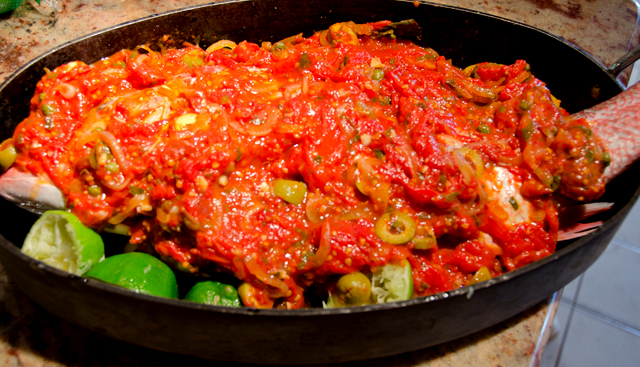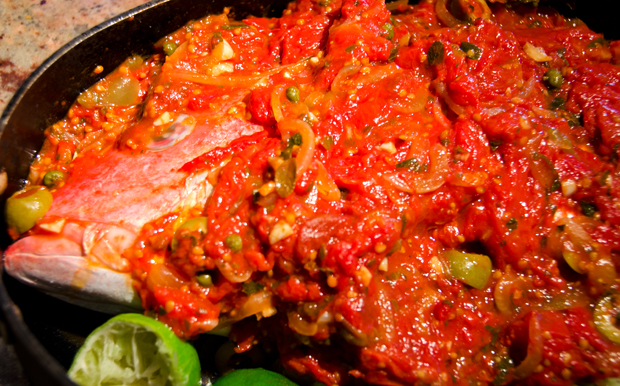With influences from both Old and New World cuisine, red snapper veracruzana is a classic Mexican dish with definite Spanish overtones. When the Spanish explorer Hernan Cortes landed on the southeastern gulf area of Mexico on Good Friday, 1519 he gave it the name “Villa Rica de la Vera Cruz” which translates to the rich village of the true cross. Rich not just in the abundance of the gold and silver that they would soon find here but in seafood, tomatoes, peppers, and vanilla as well as their diet staples, corn, beans and squash. Cultivated first by the Mayans and later by the Aztecs, the Spanish introduced the tomato throughout their empire. The Spanish conquistadors in turn brought parsley, cilantro and thyme, as well as garlic, onions and olives to the coastal Mexican cuisine which influences it to this day. Red snapper or huachinango as it it called in Mexico, is nestled in a sauce of rich ripe tomatoes, onions and garlic with a salty tang that comes from Manzanilla (Spanish) olives and capers. Pickled jalapenos add tartness and only a moderate amount of spice. I like to make my own pickled jalapenos in late summer when our pepper plants are prolific. I used a whole fish in this preparation but don’t let that stop you from trying this recipe. The sauce would be just as good on fish fillets or even shrimp.
Red Snapper Veracruzana
Slightly adapted from Mexico One Plate at a Time
Serves four to six
Ingredients
- One 4 pound cleaned and scaled firm meaty fish, such as snapper, grouper, striped bass, pompano (ask your fishmonger to cut out the red gills and trim off the fins at the top, bottom and alongside the gills. An easier approach, to feed four, use four 5-6 ounce boneless skinless fish fillets of the same type of fish named above. You will not need as much sauce, only about five cups will be needed for this recipe. Reserve the rest for another use.
- 2 limes juiced
- Kosher Salt
- 1/4c olive oil
- 1 medium white onion, thinly sliced
- 4 large cloves of garlic, peeled and finely chopped
- 3lbs ripe tomatoes, cored and chopped into 1/2 in pieces (7 cups)
- 3 fresh Turkish bay leaves
- 1 1/2 teaspoons dried Mexican oregano (can substitute standard oregano)
- 3T chopped flat leafed parsley
- 1c pitted and roughly chopped Manzanilla olives
- 1/4c capers, drained and rinsed
- 3 or 4 pickled jalapeno peppers, stemmed, seeded and thinly sliced
Directions
- Cut two parallel slashes across each side of the fish, cutting through the flesh to the backbone. Place the fish in a baking dish large enough to hold it comfortably. Drizzle both sides of the fish with the lime juice and sprinkle generously with salt. Cover and refrigerate from one to four hours.
- In a five quart Dutch oven, heat the oil over medium heat. Add the onion and cook, stirring regularly, until just beginning to brown, about 5 minutes. Add the garlic and cook 1 minute more, stirring occasionally. Raise the heat to medium high and add the tomatoes, bay leaves, oregano, parsley and half of the olives, capers and chiles. Simmer briskly, stirring frequently, for about 5 minutes to evaporate some of the liquid. Reduce the heat to medium low, stir in one cup of water and simmer for 15 minutes. Taste and season with salt to taste. Remove from the heat.
- Heat the oven to 350°F. Lightly oil a roasting pan large enough to hold the fish comfortably. Remove the fish from the lime marinade and lay it in the pan. Cover the fish with the tomato sauce. Bake in the center of the oven until internal temperature of fish is about 140°F or until flesh is opaque and separates easily with a fork, start checking at the 35 minute mark. Prepare a serving platter large enough to hold the entire fish. Use two sturdy large metal spatulas to transfer the fish from the baking pan to the serving platter. Spoon up the rest of the sauce from the pan and cover the fish. Sprinkle your finished dish with the remaining olives, capers and parsley.
- To serve your beautiful presentation, set out the spatulas you used to move the fish from the pan to the plate along with a very sharp knife.Using the sharp knife , cut between the head and body until the knife touches the backbone. Repeat on tail end. Insert knife at tail end, and cut from backbone to cavity. With knife resting against backbone, cut up to head. Insert a spatula underneath flesh of fish, on top of the backbone and lift. Lift tail; remove backbone.If desired, remove skin from fillet.


